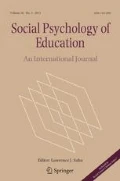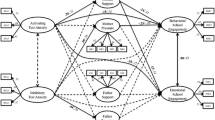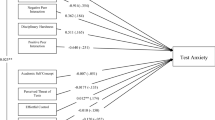Abstract
This study examined predictors of test anxiety in a sample of 2528 Norwegian upper-secondary and postsecondary students by means of structural equation modeling. Results showed that personal goals related to career and grades positively predicted test anxiety, whereas self-efficacy beliefs were a negative predictor of test anxiety. In turn, participants’ personal goals and self-efficacy beliefs were predicted by perceived family expectation and gender and, thus, mediated the effects of those variables on test anxiety. Specifically, academic expectations from students’ families had an indirect positive effect on test anxiety mediated by career goal and an indirect negative effect on test anxiety mediated by self-efficacy beliefs, and gender indirectly affected test anxiety through self-efficacy beliefs (with females displaying lower self-efficacy beliefs than males). Finally, both family expectation and gender also had direct effects on test anxiety. The unique contribution of this large scale study is highlighted and theoretical and educational implications are discussed.


Similar content being viewed by others
References
Agliata, K. A., & Renk, K. (2009). College students’ affective distress: The role of expectation discrepancies and communication. Journal of Child and Family Studies, 18, 396–411.
Bandura, A. (1997). Self-efficacy: The exercise of control. New York: Freeman.
Bentler, P. M. (1990). Comparative fit indexes in structural models. Psychological Bulletin, 107, 238–246.
Bentler, P. M., & Bonett, D. G. (1980). Significance tests and goodness of fit in the analysis of covariance structures. Psychological Bulletin, 88, 588–606.
Besharat, M. A. (2003). Parental perfectionism and children’s test anxiety. Psychological Reports, 93, 1049–1055.
Boekaerts, M. (2009). Goal-directed behavior in the classroom. In K. R. Wentzel & A. Wigfield (Eds.), Handbook of motivation at school (pp. 105–122). New York: Routledge.
Bowers, E. P., Gestsdottir, S., Geldhof, G. J., Nikitin, J., von Eye, A., & Lerner, R. M. (2011). Developmental trajectories of intentional self-regulation in adolescence: The role of parenting and implications for positive and problematic outcomes among diverse youth. Journal of Adolescence, 34, 1193–1206.
Brady, S. T., Martin Hard, B., & Gross, J. J. (2018). Reappraising test anxiety increases academic performance of first-year college students. Journal of Educational Psychology, 110, 395–406.
Bråten, I., & Olaussen, B. S. (1998). The learning and study strategies of Norwegian first-year college students. Learning and Individual Differences, 10, 309–327.
Bråten, I., & Olaussen, B. S. (2000). Motivation in college: Understanding Norwegian college students’ performance on the LASSI Motivation subscale and their beliefs about academic motivation. Learning and Individual Differences, 12, 177–187.
Brown, T. A. (2015). Confirmatory factor analysis for applied research (2nd ed.). New York: Guilford.
Cassady, J. C. (2004). The influence of cognitive test anxiety across the learning–testing cycle. Learning and Instruction, 14, 569–592.
Diaconu-Gherasim, L. R., & Măirean, C. (2016). Perception of parenting styles and academic achievement: The mediating role of goal orientations. Learning and Individual Differences, 49, 378–385.
Drach-Zahavy, A., & Erez, M. (2002). Challenge versus threat effects on the goal–performance relationship. Organizational Behavior and Human Decision Processes, 88, 667–682.
Eccles, J. S. (2007). Families, schools, and developing achievement-related motivation and engagement. In J. E. Grusec & P. D. Hastings (Eds.), Handbook of socialization: Theory and research (pp. 665–691). New York: Guilford.
Else-Quest, N. M., Higgins, A., Allison, C., & Morton, L. C. (2012). Gender differences in self-conscious emotional experience: A meta-analysis. Psychological Bulletin, 138, 947–981.
Erzen, E., & Odacı, H. (2016). The effect of the attachment styles and self-efficacy of adolescents preparing for university entrance tests in Turkey on predicting test anxiety. Educational Psychology, 36, 1728–1741.
Folkman, S., & Lazarus, R. S. (1985). If it changes it must be a process: Study of emotion and coping during three stages of a college examination. Journal of Personality and Social Psychology, 48, 150–170.
Froiland, J. M., & Davison, M. L. (2014). Parental expectations and school relationships as contributors to adolescents’ positive outcomes. Social Psychology of Education, 17, 1–17.
Gogol, K., Brunner, M., Goetz, T., Martin, R., Ugen, S., Keller, U., et al. (2014). “My questionnaire is too long!” The assessment of motivational-affective constructs with three-item and single-item measures. Contemporary Educational Psychology, 39, 188–205.
Grolnick, W. S., Friendly, R. W., & Bellas, V. M. (2009). Parenting and children’s motivation at school. In K. R. Wentzel & A. Wigfield (Eds.), Handbook of motivation at school (pp. 280–300). New York: Routledge.
Gugiu, C., & Gugiu, M. (2018). Determining the minimum reliability standard based on a decision criterion. Journal of Experimental Education, 86, 458–472.
Hagtvet, K. A. (1983). A measurement study of test anxiety emphasizing its evaluative context. In S. H. Irvine & J. W. Berry (Eds.), Human assessment and cultural factors (pp. 393–405). Boston, MA: Springer.
Hagtvet, K. A., Man, F., & Sharma, S. (2001). Generalizability of self-related cognitions in test anxiety. Personality and Individual Differences, 31, 1147–1171.
Hembree, R. (1988). Correlates, causes, effects, and treatment of test anxiety. Review of Educational Research, 58, 47–77.
Hu, L. T., & Bentler, P. M. (1998). Fit indices in covariance structure modeling: Sensitivity to underparameterized model misspecification. Psychological Methods, 3, 424–453.
Hu, L. T., & Bentler, P. M. (1999). Cutoff criteria for fit indexes in covariance structure analysis: Conventional criteria versus new alternatives. Structural Equation Modeling: A Multidisciplinary Journal, 6, 1–55.
Jacobs, J. E., Chhin, C. S., & Bleeker, M. M. (2006). Enduring links: Parents’ expectations and their young adult children’s gender-typed occupational choices. Educational Research and Evaluation, 12, 395–407.
Jodl, K. M., Michael, A., Malanchuk, O., Eccles, J. S., & Sameroff, A. (2001). Parents’ roles in shaping early adolescents’ occupational aspirations. Child Development, 72, 1247–1265.
Juang, L. P., & Silbereisen, R. K. (2002). The relationship between adolescent academic capability beliefs, parenting, and school grades. Journal of Adolescence, 25, 3–18.
Kerlinger, F. N., & Lee, H. B. (2000). Foundations of behavioral research (4th ed.). Fort Worth, TX: Harcourt College Publishers.
Lent, R. W., Brown, S. D., & Hackett, G. (1994). Toward a unifying social cognitive theory of career and academic interest, choice, and performance. Journal of Vocational Behavior, 45, 79–122.
Luszczynska, A., Benight, C. C., & Cieslak, R. (2009). Self-efficacy and health-related outcomes of collective trauma. European Psychologist, 14, 51–62.
Marsh, H. W., Hau, K. T., & Wen, Z. (2004). In search of golden rules: Comment on hypothesis-testing approaches to setting cutoff values for fit indexes and dangers in overgeneralizing Hu and Bentler’s (1999) findings. Structural Equation Modeling: A Multidisciplinary Journal, 11, 320–341.
Maxwell, S. E. (2004). The persistence of underpowered studies in psychological research: Causes, consequences, and remedies. Psychological Methods, 9, 145–165.
McKeachie, W. J. (1951). Anxiety in the college classroom. The Journal of Educational Research, 45, 153–160.
Michaels, E., Handfield-Jones, H., & Axelrod, B. (2001). The war for talent. Boston, MA: Harvard Business Review Press.
Moos, R. H., & Moos, B. S. (1986). Family Environment Scale manual. Palo Alto, CA: Consulting Psychologists Press.
Muthén, L. K., & Muthén, B. (2012). Mplus user’s guide Version 7. Los Angeles, CA: Muthén & Muthén.
Naumann, L. P., Guillaume, E. M., & Funder, D. C. (2012). The correlates of high perceived parental academic expectations: An Asian-Latino comparison. Journal of Cross-Cultural Psychology, 43, 515–520.
Nichols, S. L., & Berliner, D. C. (2007). Collateral damage: How high-stakes testing corrupts America’s schools. Cambridge, MA: Harvard University Press.
OECD. (2013). Trends shaping education 2013. Paris: OECD Publishing. https://doi.org/10.1787/trends_edu-2013-en.
Olson, D. H., Russell, C. S., & Sprenkle, D. H. (1983). Circumplex model of marital and family systems: Cohesion and adaptability dimensions, family types, and clinical applications. Family Process, 18, 3–28.
Osbourne, J. W. (2006). Gender, stereotype threat, and anxiety: Psychophysiological and cognitive evidence. Journal of Research in Educational Psychology, 8, 109–138.
Pekrun, R. (2006). The control-value theory of achievement emotions: Assumptions, corollaries, and implications for educational research and practice. Educational Psychology Review, 18, 315–341.
Peleg, O., Deutch, C., & Dan, O. (2016). Test anxiety among female college students and its relation to perceived parental academic expectations and differentiation of self. Learning and Individual Differences, 49, 428–436.
Peleg, O., Klingman, A., & Abu-Hana Nahhas, I. (2003). Cross-cultural and familial differences between Arab and Jewish adolescents in test anxiety. International Journal of Intercultural Relations, 27, 525–541.
Peleg-Popko, O. (2002). Children’s test anxiety and family interaction patterns. Anxiety Stress and Coping, 15, 45–59.
Peleg-Popko, O., & Klingman, A. (2002). Family environment, discrepancies between perceived actual and desirable environment, and children’s test and trait anxiety. British Journal of Guidance and Counselling, 30, 451–466.
Pintrich, P. R., Smith, D. A. F., Garcia, T., & McKeachie, W. J. (1993). Reliability and predictive validity of the Motivated Strategies for Learning Questionnaire. Educational and Psychological Measurement, 53, 801–813.
Pomerantz, E. M., Grolnick, W. S., & Price, C. E. (2005). The role of parents in how children approach achievement: A dynamic process perspective. In A. J. Elliot & C. S. Dweck (Eds.), Handbook of competence and motivation (pp. 259–278). New York: Guilford.
Putwain, D. W. (2008). Test anxiety and GCSE performance: The effect of gender and socio- economic background. Educational Psychology in Practice, 24, 319–334.
Putwain, D., & Daly, A. L. (2014). Test anxiety prevalence and gender differences in a sample of English secondary school students. Educational Studies, 40, 554–570.
Ringeisen, T., & Raufelder, D. (2015). The interplay of parental support, parental pressure and test anxiety: Gender differences in adolescents. Journal of Adolescents, 45, 67–79.
Roick, J., & Ringeisen, T. (2017). Self-efficacy, test anxiety, and academic success: A longitudinal validation. International Journal of Educational Research, 83, 84–93.
Sarason, I. G. (1984). Stress, anxiety, and cognitive interference: Reactions to tests. Journal of Personality and Social Psychology, 46, 929–938.
Sarason, S. B., & Mandler, G. (1952). Some correlates of test anxiety. The Journal of Abnormal and Social Psychology, 47, 810–817.
Schermelleh-Engel, K., Moosbrugger, H., & Müller, H. (2003). Evaluating the fit of structural equation models: Tests of significance and descriptive goodness-of-fit measures. Methods of Psychological Research Online, 8(2), 23–74.
Schneider, F. W., Gruman, J. A., & Coutts, L. M. (Eds.). (2005). Applied social psychology: Understanding and addressing social and practical problems. Thousand Oaks, CA: Sage.
Schunk, D. H., Meece, J. L., & Pintrich, P. R. (2014). Motivation in education: Theory, research, and applications (4th ed.). Columbus, OH: Pearson Merrill Prentice Hall.
Spielberger, C. D., Anton, W. D., & Bedell, J. (1976). The nature and treatment of test anxiety. In M. Zuckerman & C. D. Spielberger (Eds.), Emotions and anxiety: New concepts, methods, and applications (pp. 317–344). New York: Wiley.
Statistics Norway. (2014). Key figures on gender equality. Retrieved from www.ssb.no/befolkning/nokkeltall/key-figures-on-gender-equality.
UK Parliament. (2008). The children, schools, and families committee—Third report. Retrieved from http://publications.parliament.uk/pa/cm200708/cmselect/cmchilsch/169/16902.htm.
Undheim, J. O., Nordvik, H., Gustafsson, K., & Undheim, A. M. (1995). Academic achievement of high-ability students in egalitarian education. Scandinavian Journal of Educational Research, 39, 157–167.
von der Embse, N., Barterian, J., & Segool, N. (2013). Test anxiety interventions for children and adolescents: A systematic review of treatment studies from 2000–2010. Psychology in the Schools, 50, 57–71.
Warner-Søderholm, G. (2012). Culture matters: Norwegian cultural identity within a Scandinavian context. SAGE Open. https://doi.org/10.1177/2158244012471350.
Wigfield, A., & Eccles, J. S. (2000). Expectancy-value theory of achievement motivation. Contemporary Educational Psychology, 25, 68–81.
Wigfield, A., & Eccles, J. S. (Eds.). (2002a). Development of achievement motivation. San Diego, CA: Academic Press.
Wigfield, A., & Eccles, J. S. (2002b). The development of competence beliefs, expectancies for success, and achievement values from childhood through adolescence. In A. Wigfield & J. S. Eccles (Eds.), Development of achievement motivation (pp. 91–120). San Diego, CA: Academic Press.
World Bank. (2011). Learning for all: Investing in people’s knowledge and skills to promote development: Education sector strategy 2020. Washington, DC: The World Bank. Retrieved from http://siteresources.worldbank.org/EDUCATION/Resources/ESSU/Education_Strategy_4_12_2011.pdf.
Zeidner, M. (1998). Test anxiety: The state of the art. New York: Plenum.
Zeidner, M. (2004). Test anxiety. In C. Spielberger (Ed.), Encyclopedia of applied psychology (Vol. 3, pp. 545–556). San Diego, CA: Academic Press.
Zeidner, M. (2007). Test anxiety in educational contexts: Concepts, findings, and future directions. In P. A. Schutz & R. Pekrun (Eds.), Emotion in education (pp. 165–184). San Diego, CA: Academic Press.
Zeidner, M. (2014). Anxiety in education. In R. Pekrun & L. Linnenbrink-Garcia (Eds.), International handbook of emotions in education (pp. 265–288). New York: Routledge.
Zimmerman, B. J. (2000). Self-efficacy: An essential motive to learn. Contemporary Educational Psychology, 25, 82–91.
Author information
Authors and Affiliations
Corresponding author
Appendix
Appendix
Descriptive information about the measured variables for upper-secondary and postsecondary students separately
Upper-secondary students (n = 1566, 59% female) | Higher education students (n = 962, 68% female) | |||
|---|---|---|---|---|
M | SD | M | SD | |
Family expectation | 5.77 | 1.20 | 5.28 | 1.33 |
Career goal | 4.36 | 1.85 | 4.16 | 1.79 |
Grade ambition | 0.65 | 0.58 | 0.81 | 0.80 |
Self-efficacy | 5.13 | 1.19 | 4.94 | 1.20 |
Test anxiety | 4.51 | 1.65 | 4.64 | 1.65 |
Rights and permissions
About this article
Cite this article
Brandmo, C., Bråten, I. & Schewe, O. Social and personal predictors of test anxiety among Norwegian secondary and postsecondary students. Soc Psychol Educ 22, 43–61 (2019). https://doi.org/10.1007/s11218-018-9461-y
Received:
Accepted:
Published:
Issue Date:
DOI: https://doi.org/10.1007/s11218-018-9461-y




